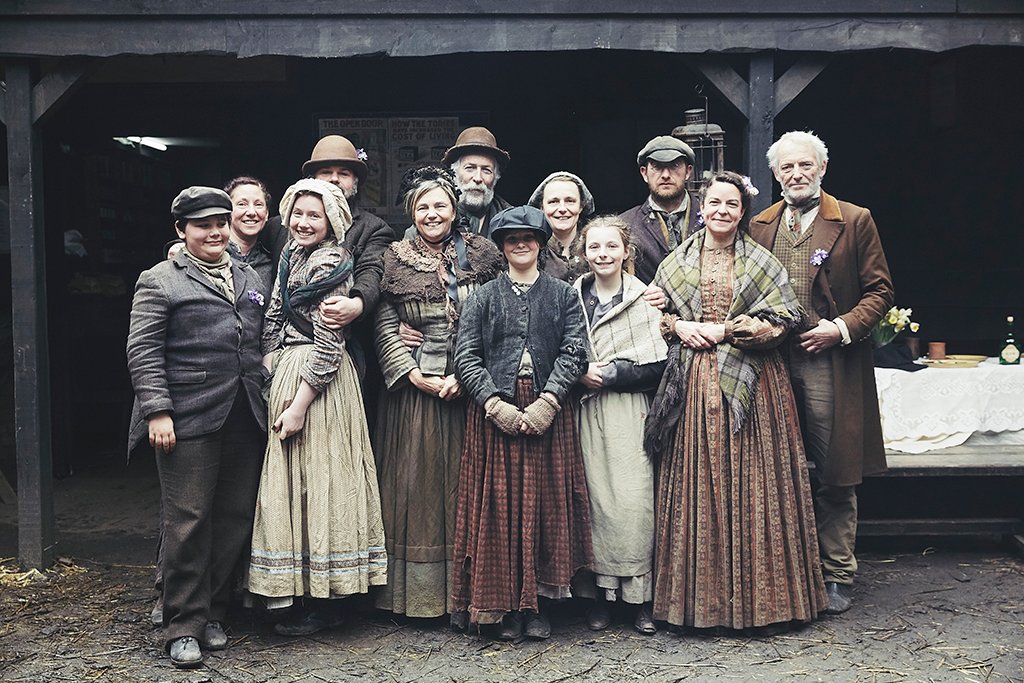Blog
Poor Victorian Era Fashion: The Struggle for Style and Comfort

Fashion in the Victorian era was intricate and varied. But, not everyone could afford the latest trends.
For many, the Victorian era meant struggling to stay warm and decent. The wealthy flaunted elaborate dresses and suits, while the poor made do with whatever they could find. Clothes were often hand-me-downs, patched, and worn out. Despite this, the poor found ways to adapt and create their own unique styles.
Their fashion was a testament to resilience and creativity. They used simple fabrics and practical designs. They valued durability over flair. This blog will delve into the world of poor Victorian fashion, exploring how they dressed and why their choices were significant. Discover the hidden stories behind the humble garments of the time.
Introduction To Victorian Fashion
The Victorian era, spanning from 1837 to 1901, was a time of significant change. Queen Victoria’s reign saw dramatic shifts in fashion. Poor Victorian fashion reflected societal norms and economic conditions. Clothing was much more than just fabric; it was a statement of one’s place in society.
Social Hierarchy And Clothing
Clothing in the Victorian era clearly marked social status. The wealthy flaunted elaborate, custom-made garments. These often included luxurious fabrics like silk and velvet. On the other hand, the poor wore simple, practical clothing. Their outfits were made from cheaper materials, such as wool or cotton. The difference in attire was stark and easily noticeable.
Rich women wore dresses with intricate details. These dresses had layers, frills, and corsets. Poor women wore plain dresses, often hand-me-downs. Men’s fashion also varied greatly. Wealthy men wore tailored suits and top hats. Poor men wore simple trousers and shirts. The quality and style of clothing highlighted one’s social rank.
Influence Of Industrial Revolution
The Industrial Revolution had a significant impact on fashion. It made clothing more accessible to the masses. Factories could produce garments quickly and cheaply. This was a boon for the poor, who could now afford new clothes. Mass production reduced the cost of fabrics and ready-made clothing. Despite this, there remained a clear divide in fashion quality.
New machinery and techniques made intricate designs possible. Even cheaper fabrics could be made to look elegant. Yet, the rich still preferred custom-made attire. They saw it as a mark of exclusivity. The Industrial Revolution democratized fashion to an extent. But social distinctions remained evident in Victorian attire.
Materials And Fabrics
The Victorian Era was a period of stark contrasts in fashion. The materials and fabrics used in clothing reflected the social and economic status of individuals. Let’s delve into the common fabrics and the quality of materials that defined this era.
Common Fabrics Used
During the Victorian Era, several fabrics were prevalent. These fabrics varied in texture, durability, and affordability. Here’s a list of the most common ones:
- Cotton: Widely used for its affordability and comfort.
- Wool: Known for its warmth, commonly used in winter garments.
- Silk: A luxury fabric, often used by the wealthy for elegant attire.
- Linen: Lightweight and breathable, ideal for summer clothing.
- Velvet: A rich fabric, used in high-fashion and formal wear.
These fabrics were often chosen based on the occasion, season, and the wearer’s social status.
Quality Of Materials
The quality of materials in the Victorian Era varied greatly. There was a stark contrast between what the rich and poor could afford. Here is a comparison:
| Quality | Rich | Poor |
|---|---|---|
| Fabric | High-quality silk, velvet, and fine wool. | Coarse cotton, rough wool, and cheap blends. |
| Durability | Long-lasting and well-maintained. | Quick to wear out and often patched. |
| Appearance | Sleek, clean, and stylish. | Worn-out, faded, and often dirty. |
These differences in material quality illustrated the economic divide of the era. The wealthy flaunted their status through luxurious fabrics, while the poor made do with whatever they could afford.
Typical Outfits
In the Poor Victorian Era, typical outfits had a distinct and practical style. Clothes were often worn until they were threadbare. People patched and mended them many times. Despite the hardships, there was a clear difference between men’s and women’s clothing.
Men’s Clothing
Men’s outfits were simple and functional. Most men wore trousers, a shirt, and a coat. Trousers were usually dark and made of wool or cotton. Shirts were light-colored and made from linen. Coats were worn for warmth and protection.
Men often wore waistcoats over their shirts. Waistcoats added a layer of warmth and style. Hats were common, with flat caps and bowler hats being the most popular. Shoes were heavy and durable, often made of leather. Men needed them to last a long time.
Women’s Clothing
Women’s clothing was more elaborate than men’s, despite the poverty. Dresses were the main garment, often made of cotton or wool. These dresses had high necklines and long sleeves for modesty. Skirts were long, reaching down to the ankles.
Women wore aprons over their dresses to protect them from dirt. Shawls and bonnets were essential accessories. Shawls added warmth, while bonnets protected them from the sun. Shoes were practical, usually made of leather or sturdy fabric. Women often had only one pair of shoes to last several years.
Challenges Of Comfort
Poor Victorian Era fashion was not just about appearance. It was also about enduring discomfort. The fashion choices of the time presented various challenges. The restrictive clothing made daily life difficult. Let’s dive into some of the most significant comfort challenges faced by people of this era.
Constraining Corsets
Corsets were a staple of Victorian fashion. They were designed to cinch the waist and accentuate the hourglass figure. Wearing a corset was not a choice but a necessity. These garments were often tight and restrictive. Breathing deeply was a challenge. Physical activities were limited. Many women experienced fainting spells.
Doctors noted health problems caused by corsets. Issues included:
- Compressed lungs
- Displaced organs
- Poor digestion
Despite the discomfort, corsets remained popular. They symbolized beauty and social status.
Heavy Layers
Another challenge was the multiple layers of clothing. People wore several layers to adhere to societal norms. The layers included:
- Chemises
- Petticoats
- Bodices
- Overdresses
These layers were often made of heavy fabrics. They were cumbersome and added significant weight. Moving freely was almost impossible. The clothing was also difficult to clean. Keeping layers fresh and tidy was a constant struggle.
Heavy layers were not just uncomfortable. They also posed health risks. The weight and lack of ventilation caused overheating. The risk of heatstroke was high, especially during summer.
In the Victorian Era, fashion was a matter of endurance. The quest for beauty came at a high price. Daily comfort was sacrificed for societal expectations.
Maintenance And Hygiene
During the Victorian era, fashion was elaborate and intricate. But maintaining these garments was a challenge. Poor hygiene standards and lack of proper maintenance often led to issues. Let’s explore the specifics of how Victorians managed their clothing, focusing on washing and cleaning, and the lifespan of clothing.
Washing And Cleaning
Victorian clothing was difficult to clean. Most garments were made from delicate fabrics. These fabrics needed special care. People often washed clothes by hand. This was a time-consuming task.
Soap was harsh and could damage fabrics. Stains were common and hard to remove. People used methods like rubbing with bread or chalk. Bleaching was a risky process. It could weaken the fabric.
Below is a table showing common cleaning methods:
| Method | Material | Effectiveness |
|---|---|---|
| Hand Washing | All Fabrics | Moderate |
| Rubbing with Bread | Delicate Fabrics | Low |
| Bleaching | White Fabrics | High but Risky |
Lifespan Of Clothing
Victorian clothing had a short lifespan. Frequent washing and poor hygiene practices weakened the fabrics. Most people had limited wardrobes. They wore the same clothes often.
Clothing was expensive. Families passed down garments. Mending and repairing clothes was common. Women often reused old clothes to make new garments.
Here are some points about the lifespan of Victorian clothing:
- Frequent mending and repairing
- Reusing old garments
- Limited wardrobe
- High cost of new clothing
Despite these efforts, clothing did not last long. The constant wear and cleaning wore out fabrics quickly. Maintaining hygiene was a constant struggle.

Credit: uk.pinterest.com
Economic Constraints
The Victorian Era was a time of elegance. But for the poor, economic constraints shaped their fashion choices. They couldn’t afford the luxurious fabrics and elaborate styles of the wealthy. Their clothing was practical and worn for long periods. Let’s delve into the economic factors that influenced their fashion choices.
Cost Of Fashion
Fashion was expensive in the Victorian Era. Many families had limited budgets. Buying new clothes was rare. They had to prioritize food and rent over fashion. The cost of fabrics and clothing materials was high. Only the wealthy could afford frequent new outfits.
Second-hand Clothing
Second-hand clothing was common among the poor. It was a practical solution to their economic constraints. Many relied on hand-me-downs from family members. Thrift shops and street vendors sold used clothes at lower prices. The garments were often worn out and repaired multiple times. This made them affordable for the poor.
Fashion Adaptations
During the Victorian era, fashion was elaborate and expensive. Poor people could not afford the luxury of new clothes. They had to find creative ways to keep up with trends. They used their skills and resourcefulness to adapt and make do with what they had. This section explores some of the ingenious fashion adaptations of the Victorian poor.
Diy Alterations
The poor often resorted to DIY alterations to update their wardrobes. Clothes were patched and mended over and over. They used every bit of fabric they could find. Here are some common DIY techniques:
- Patchwork: Sewing patches onto worn areas to extend the life of garments.
- Hand-me-downs: Modifying clothes passed down from older siblings or adults.
- Upcycling: Repurposing old garments into new items, like turning a dress into a shirt.
These methods kept their clothes functional and somewhat fashionable. It was an essential skill for survival.
Use Of Accessories
Accessories played a crucial role in Victorian fashion. They allowed the poor to change their appearance without buying new clothes. Some common accessories included:
- Scarves: Worn in various styles to cover worn collars or add a pop of color.
- Hats: Essential for both protection and fashion, often made or altered at home.
- Jewelry: Simple pieces made from inexpensive materials like beads and ribbon.
These accessories were often handmade. They added a touch of elegance to otherwise plain outfits. Even the poorest could show their creativity and personal style through these small details.

Credit: www.pinterest.com
Cultural And Social Impact
The Victorian era, marked by Queen Victoria’s reign from 1837 to 1901, had a profound cultural and social impact. The fashion of this period reflected societal norms, beliefs, and values. This section delves into how clothing shaped identity and highlighted class distinctions.
Identity And Clothing
Clothing in the Victorian era was more than just attire. It was a statement of identity. People used fashion to express their social status, profession, and personality. The rich adorned themselves in elaborate garments. Silk, velvet, and lace were common. These materials symbolized wealth and sophistication. Poor individuals wore simple, practical clothing. Their attire was often made from coarse fabrics like wool or cotton.
Fashion also reflected gender roles. Men wore suits that signified their role as providers. Women’s clothing emphasized modesty and femininity. The corset was a key garment. It shaped the body to fit the ideal of beauty at the time. This garment was uncomfortable yet essential for women of all classes. Even the poor attempted to mimic the styles of the wealthy, despite their limited resources.
Class Distinctions
Class distinctions were starkly visible through clothing. The wealthy had the means to change outfits multiple times a day. They had specific attire for different activities. Morning dresses, afternoon dresses, and evening gowns were common. Each had its unique style and purpose. They showcased the wearer’s affluence and leisure time.
In contrast, the poor had limited wardrobes. They often owned just a few sets of clothes. These garments were worn until they were threadbare. Hand-me-downs and mended clothes were typical. The working class needed durable clothing. Their attire had to withstand harsh working conditions. Despite the practicality, they aimed to follow fashion trends as best they could.
Servants’ clothing was another indicator of class. They wore uniforms provided by their employers. These uniforms were simple yet neat. They distinguished servants from the family they served. The quality of a servant’s uniform also reflected the employer’s wealth.
Fashion thus served as a visual marker of class divisions. It reinforced the social hierarchy. It dictated how people interacted with each other. The elaborate and distinct clothing of the rich created an air of exclusivity. The simple clothing of the poor signified their struggle and resilience.

Credit: www.youtube.com
Frequently Asked Questions
What Was Typical Poor Victorian Clothing?
Poor Victorians wore simple, worn-out clothes. Men wore trousers and shirts, while women wore plain dresses. Clothes were often mended.
How Did Poor Victorians Get Their Clothes?
Poor Victorians often relied on hand-me-downs and charity. They also bought cheap, second-hand clothes from markets.
Did Poor Victorian Children Have Special Clothes?
Poor Victorian children wore smaller versions of adult clothes. Boys wore trousers and shirts, girls wore simple dresses.
Were Shoes Common For Poor Victorians?
Shoes were a luxury for many poor Victorians. Often, they went barefoot or wore makeshift footwear.
Conclusion
Fashion in the Victorian era reflected the struggles of the poor. Heavy fabrics and impractical designs made life harder. Despite the hardship, their clothing had a unique charm. Today, we remember these styles as a testament to resilience. Studying their fashion offers insights into their daily lives.
It reminds us of the challenges they faced and overcame. Victorian fashion continues to inspire, showing how history shapes style.









